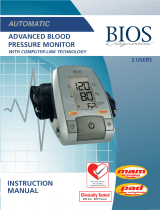
— After consuming alcohol
— After taking a bath
• The pulse display is not suitable for checking the frequency of heart
pacemakers.
• If you have been diagnosed with a severe arrhythmia or irregular heartbeat,
vascular constriction, liver disorders, or diabetes, have a cardiac pacemaker,
or are pregnant, measurements made with this instrument should only be
evaluated after consultation with your doctor.
• Take care while handling the batteries in the device. Incorrect usage may
cause battery uid leakage. To prevent such accidents, refer to the following
instructions:
— Insert batteries with the correct polarity.
— Turn off power after use. Remove and store the batteries if you are
not planning to use the device for an extended period of time.
— Do not mix different types, brands, or size of batteries. This may
cause damage to the product
— Do not mix old and new batteries.
— Remove batteries and dispose of them according to the proper
regulations in your area.
— Do not disassemble batteries or expose them to heat or re.
— Do not short-circuit the batteries.
— Do not use rechargeable batteries.
1.3 What do your Numbers Mean?
Blood pressure is the pressure in your blood vessels while blood circulates
throughout your body. High blood pressure or “Hypertension” is the pressure at
which ones normal average blood pressure is considered too high and other health
risks including: heart attack, stroke, dementia, kidney failure, heart disease and
erectile dysfunction may occur. It is expressed as two numbers: systolic/diastolic
120 mmHg/ 80 mmHg (mmHg= millimeters of mercury). “Systolic” numbers refer
to the pressure on the walls of your arteries while the heart is contracting and
pushing blood. “Diastolic” pressure is the lower number when the heart is at rest
and relaxed. A simple way to understand this is to picture a garden hose. When the
tap is turned on, the immediate pressure on the walls of the hose is the “systolic”
number, and when the tap is turned off it is the “diastolic” number.
There are many different causes of high blood pressure. We differentiate between
common primary (essential) hypertension, and secondary hypertension. The latter
group can be ascribed to specic organic malfunctions. Please consult your doctor
for information about the possible origins of your own increased blood pressure
values.






















